Personal health and wellbeing have never been more trendy than now. Moreover, the pandemic that struck the world in 2019 raised health awareness among people to a higher level. Now everyone wants to know what they eat, how many steps they walk, and how much water they drink.
These events couldn't help affect the fitness apps' niche. In 2022 the revenue of the digital fitness and wellbeing apps’ segment worldwide is expected to reach $28,2 million, which is 16.49% higher than the previous year.
However, there is another question – how to build a fitness app and stand out in such a competitive market?
Well, that's a tricky question to answer, but I will try. Based on my experience of working with fitness startups, I will shed some light on
- How to build a competitive fitness app?
- Which team do you need to help you?
- How much can fitness app development cost?
Let's start!

What are Fitness Apps?
Fitness apps are a broad niche of products that includes different categories. In general, these are digital products that help track fitness activities, health conditions, or nutrition. But before you plunge into fitness app development, you need to decide what category of fitness app you will work with:
- Activity-Tracking;
- Nutrition App;
- Workout App.

Workout Apps
This fitness app serves as a personal couch, which adapts to the user’s fitness goal.
Workout apps may offer personalized training programs and tracking activities. For example, in Sworkit, you can choose a training type (functional, stretching, or stretching) and define the timeline and goals. The service will make an individual training plan featuring video instructions for each exercise.
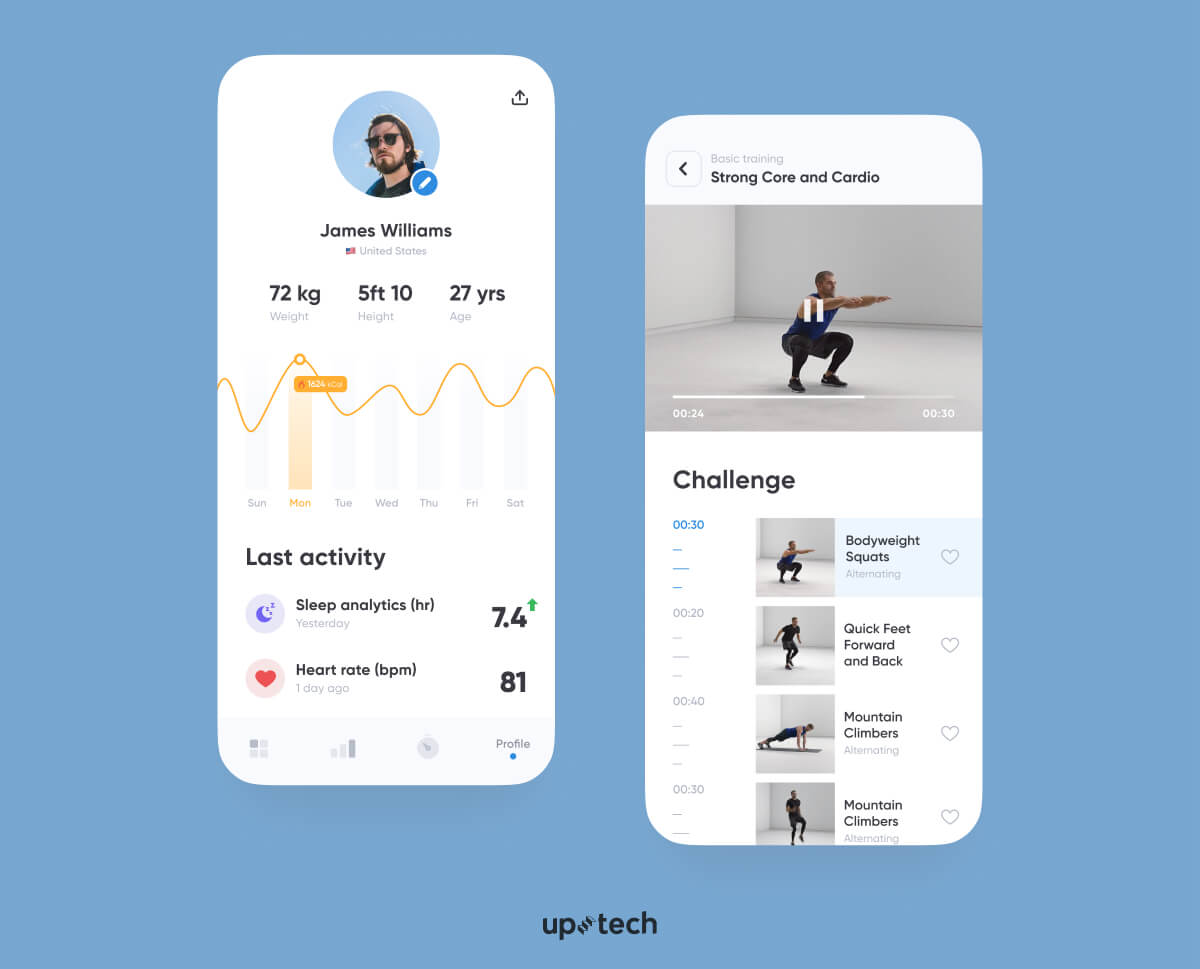
Activity-Tracking Apps
Activity-tracking fitness apps can track the user’s physical activity: the number of steps, sleep time, running speed, burnt calories, etc. This tracking functionality is possible thanks to integrating the phone’s functions (like GPS or gyroscope) or fitness trackers (Apple, Fitbit, Xiaomi Mi Band).
For example, Fitbod uses AI for tracking physical activity and creating individual training plans based on users’ goals and preferences.

Diet and Nutrition Apps
Diet and nutrition apps help users control body weight by calculating the calories consumed and burnt. Also, these apps calculate the water consumption balance and encourage healthy eating habits. Usually, such apps look like journals with recommendations created based on users’ goals: lose or gain weight nutrition plans for intensive training. However, more complicated nutrition apps, like GrowFit, allow you to communicate with professional nutrition specialists and make purchases within the app.
The cornerstone of nutrition apps is the nutrition value database. This is a collection of data about the vitamins and minerals contained in different foods.

However, working with some markets, you cannot access databases like this (or they simply do not exist). In this case, you will have to collect the database by yourself. Talk to experts, check authorized sources, and use open-access databases.
Expert’s Tip: In some domains you can find nutrition value information in governmental databases (like the Ministry of Health).
Must-Have Features of Fitness Apps
Fitness apps are a big niche, covering different categories. However, regardless of the category, there is a list of features that stay the same for any fitness app. Here are such must-have features:
Sign Up and Log In
Registration is a typical feature for any app. In fitness apps, registration helps provide a more individual experience to the user. Depending on the user’s activity and goals, you can customize the exercises or the nutrition program.
Expert’s Tip: for an MVP version of the app, you can provide registration via social media, like Facebook or Twitter. This will allow you not to waste time developing a customized registration page.
Social Media Sharing
People are competitive, it is a no-brainer. And competition is one of the strongest stimulants for doing a sports routine. By giving people the opportunity to share their achievements, you incite this positive competition among your users and help them achieve their goals faster.
Notifications and Reminders
Another way you can motivate your users is by allowing in-app notifications to remind them about their workouts. Following the workout plan, such notifications can be set up to tell users when their training is due.
Goal Setting
The goal is central to motivation in sport. That is why your fitness app should always help your users define and follow their goals. Goal-setting is a must-have feature that can be included in your app’s onboarding.
Activity Tracking
Help your user to track physical activity. You can do it simply by connecting to the smartphone sensors in watch devices. As a rule, this feature requires using Apple’s HealthKit and Google Fit to get data from Apple Watch and other trackers.
Training Schedule
Any workout program makes sense only in case it is done regularly. So it is critical that your fitness app possess such a feature.
Bar Code Scanning
You can refine your own food database by letting your users scan products’ barcodes and add them to the list.
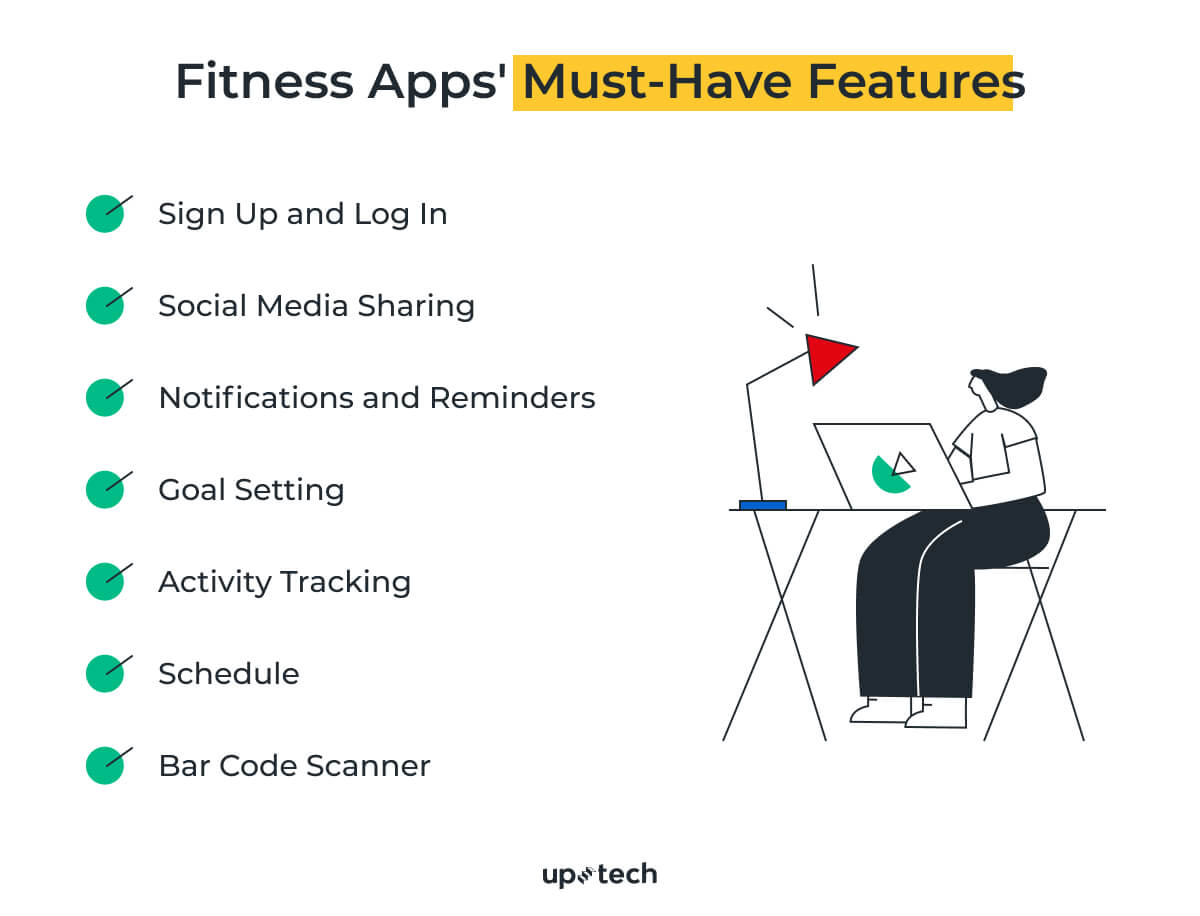
Nice-to-Have Features for Fitness Apps
Depending on the category and niche, fitness apps can also have additional functions. Here are the most popular:
Educational content
Educate your audience on physical health and nutrition. Use texts, audio records and videos, explaining which training needs to be done to achieve the goals set.
Voice management
This is a very convenient function that allows one to manage the fitness tracker without distracting the phone screen. This function is usually implemented via Google Assistant for Android devices and Siri for iOS devices.
Calorie calculation
In most cases users use fitness apps to lose weight or build muscles. Thus, users should have an opportunity to calculate how many calories they consume and burn while doing routine tasks and training.
AR integration
Now AR technologies are not very popular in fitness app development. However, we can expect them to grow in demand, especially after Facebook launched its Spark AR.
Gamification
In developing a fitness app, you can also use gamification elements to motivate users to do fitness and increase their involvement and loyalty. By gamification, we mean using game practices for motivation increase. In fitness apps, it is usually implemented via awards, leaderboards with your friends, like in NTC+, and competitions between users (ratings of leaders). Such techniques provide some challenge and support from the community, and make each user’s routine a challenging journey.
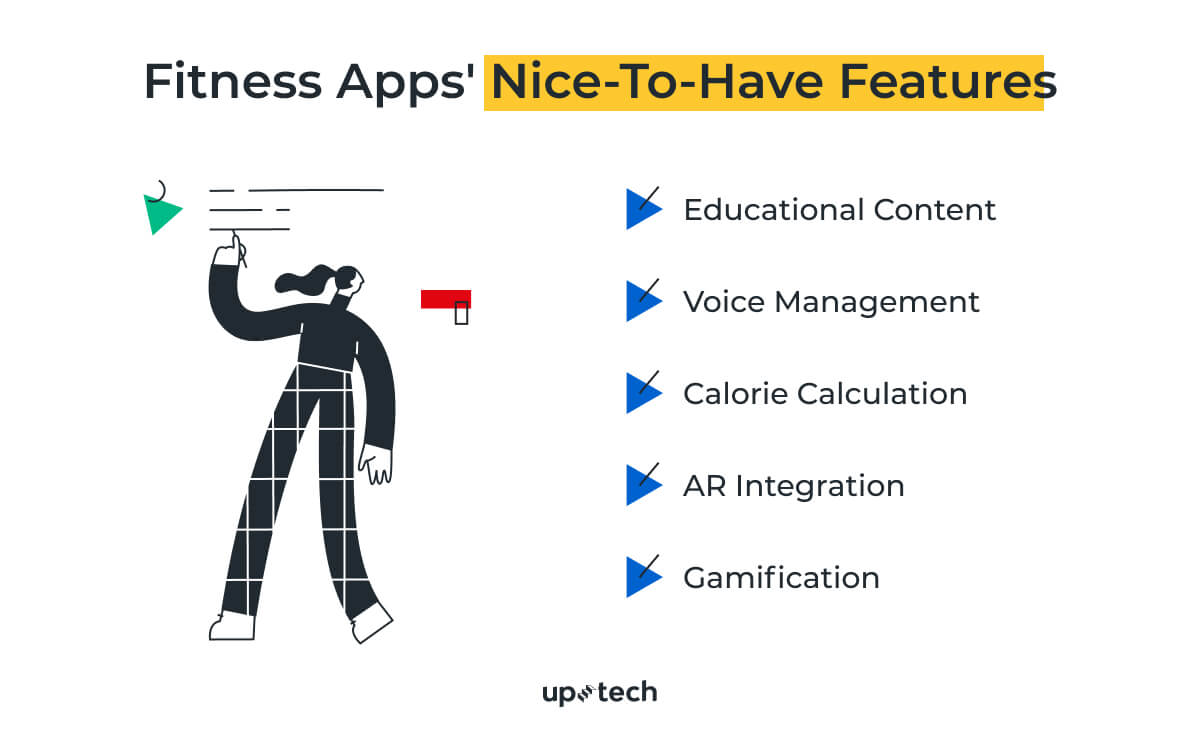
6 Steps to Build a Great Fitness App
After defining the feature set of a fitness app, the next question is – how to develop a fitness app? Here are 6 easy steps to follow in fitness app development.
Step 1. Decide on Monetization Model
How will your app earn money? That is the question you should ask yourself. Here are the monetization models to consider:
- Freemium model. This one implies that the basic functionality of apps is free. Yet, the app’s expanded functionalities are available for an extra fee—for example, ads switch-off, personal training, and individual training plans.
Example: Nike Training Club
- Subscription-based apps. Features in such apps are available by subscription only. Users can have a trial period that helps users assess the fitness app's quality and functionality before actually paying for it. A trial period often helps to create connections with users, so they are more prone to buy a subscription.
Example: Daily Burn
- In-app advertisement. You can allow other brands to display advertisements inside your app. This is a win-win-win option for brands (who increase sales), users (who use the app for free), and you, who earn with ads.
Example: 30 Day Fitness at Home
- Purchases in the app. It can be selling sports equipment, clothes or shoes, personal training, educational content, or other service or product.
Example: Runtopia
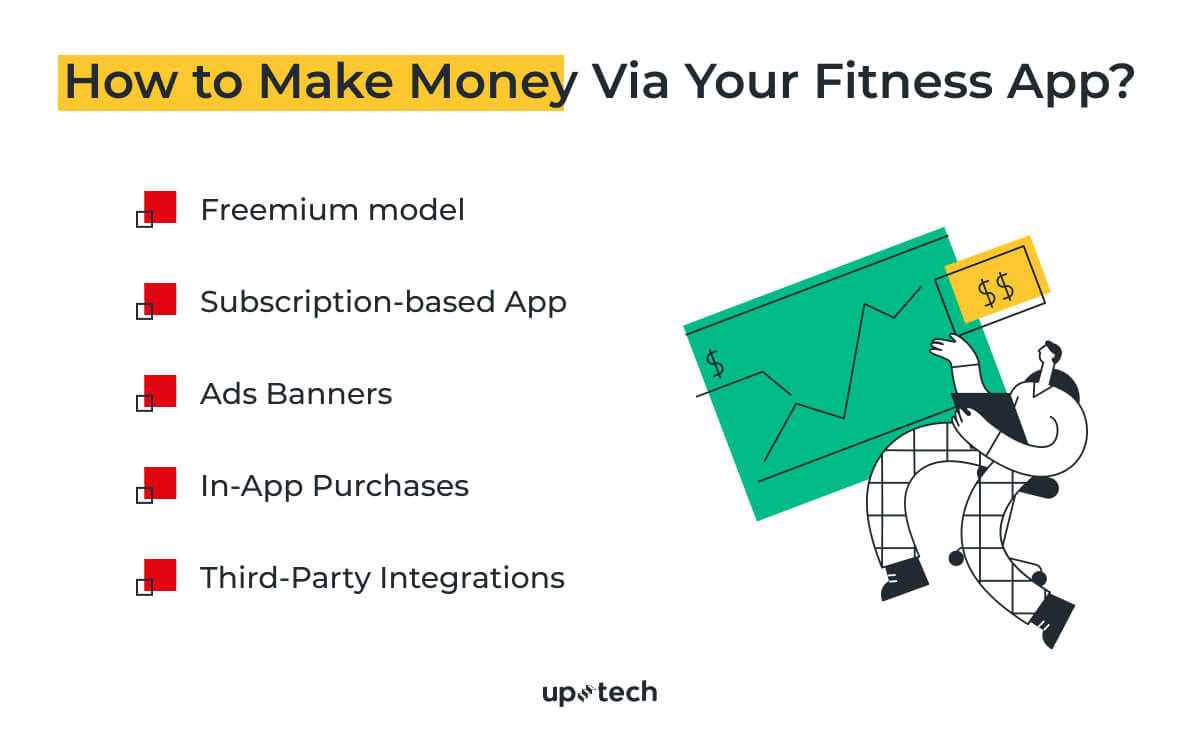
Step 2. Hire a Product Team
Creating a fitness app includes many parts: tech development, product, business management, design, marketing promotion. For some, delegating comes as a big challenge. But trying to do everything at once is way too risky. And you cannot take risks, especially in the case of startup development.
So you can always delegate the product development part to an experienced team. A product team can help you at any stage of fitness app development. In particular, a product team can help you:
- Make discovery and find a product-market fit;
- Define requirements and features’ list for your MVP;
- Run user tests and improve your product in the subsequent iterations;
- Scale your product for new markets or audiences.
Partnership with a reliable product team increases your chances for a successful product release. Do not be afraid of delegating to a dedicated team. Read our article Dedicated Team: What Is It And When Is It Used?

Step 3. Conduct Discovery
When working with an innovative product, it is essential to carry out discovery. Discovery is a preliminary stage where the product team conducts user research, explores the market, and solves a problem. The primary purposes of this stage are:
- Identify user's problem;
- Decide on your audience;
- Bring a hypothesis about how to solve it;
- Validate this hypothesis via user tests.
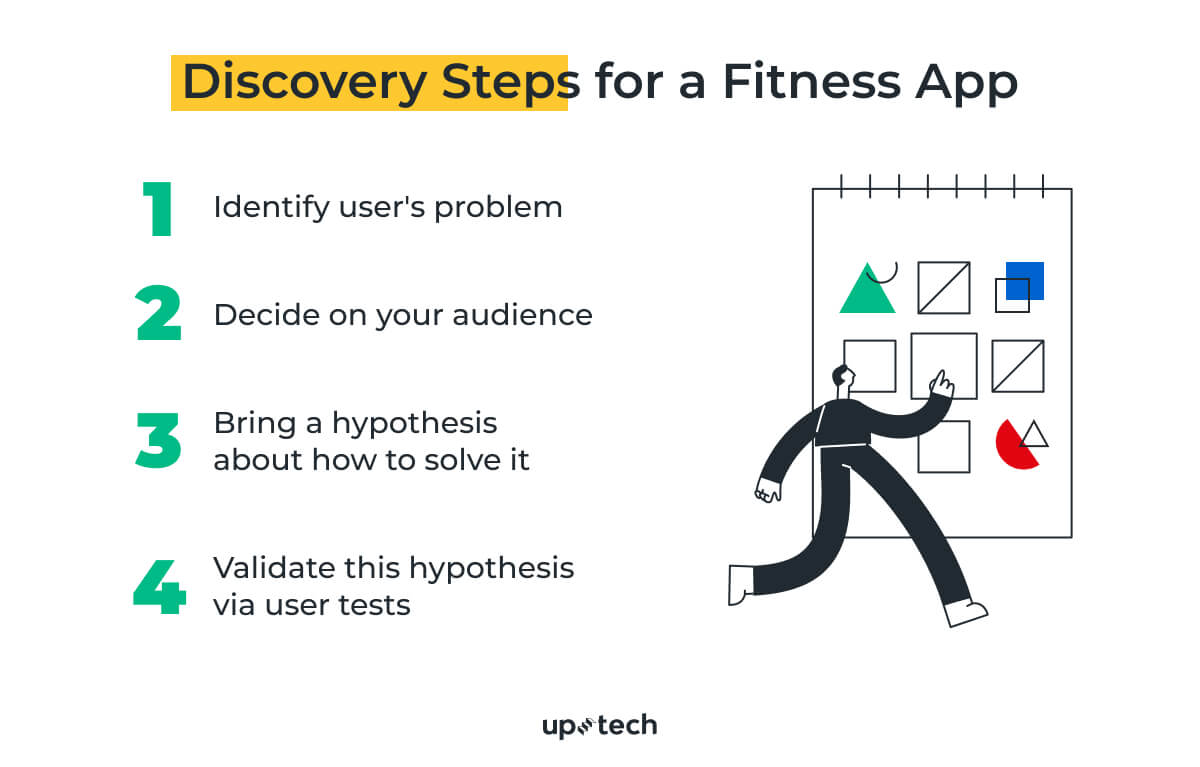
Without the Discovery stage, you risk making a product that will not match user needs. And this is the most popular scenario for startups' failures.
Step 4. Define your requirements
After the Discovery stage, you know where to move forward. However, while you know what your fitness app will be about, you still need to learn how it will implement the idea. To understand this, you need to define your product’s functional and non-functional requirements.
Requirements are usually written by Product/Project Managers in the documentation. However, documentation is important not only for managers but also for developers, stakeholders, and even designers.
Read our article about How to Write Software Documentation.
Step 5. Build an MVP
MVP is the following, more polished and improved version of the product. Unlike the prototype, this is already a fully functioning digital solution. Yet, it includes only the most basic functions. For example, in the case of a fitness app, that would be:
- Sign Up and Log In;
- Notifications;
- Training schedule.
The primary condition of a successful MVP is quickness and simplicity. These characteristics help to stand out in the super-competitive market, where products roll out every day. For your idea to be new and unique, you need to act fast. MVP is a great instrument to help you in that.

Step 6. Scale and Maintain
Another step in fitness app development would be to scale your app. App scalability means that the app should possess enough data consistency to handle a growing number of users. App scalability is directly linked to app’s architecture. It is important to plan it right from the start. This is where the product team can also help.

Wrap Up
Fitness app development is one of the most competitive niches on the market. To keep up, you need to build a quick and quality MVP. Then, a team of experienced product developers can help you throughout your journey: from Discovery to Scaling.
Contact our Business Development Manager to gather a killer team for your project!







































































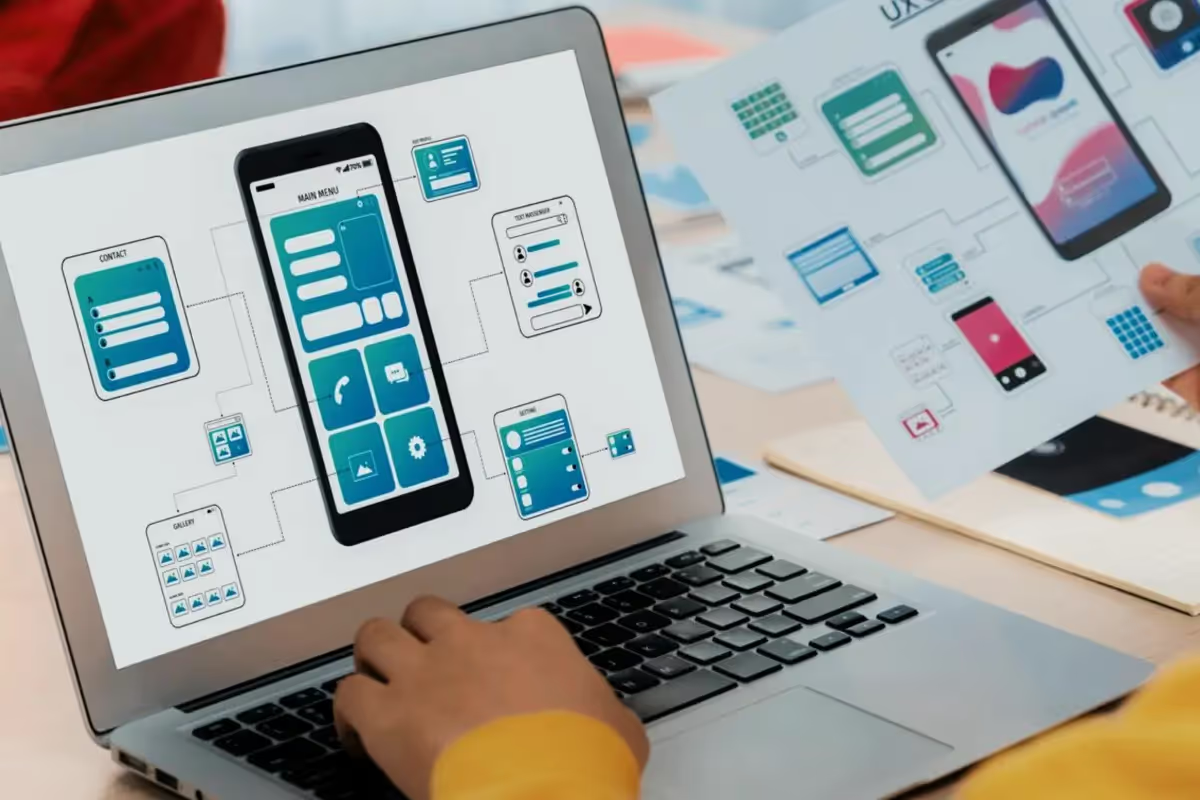















.avif)












